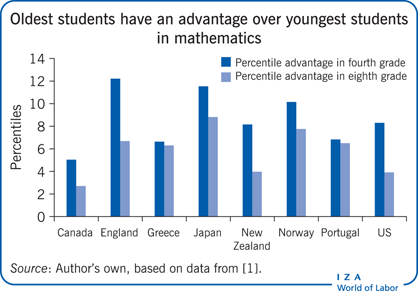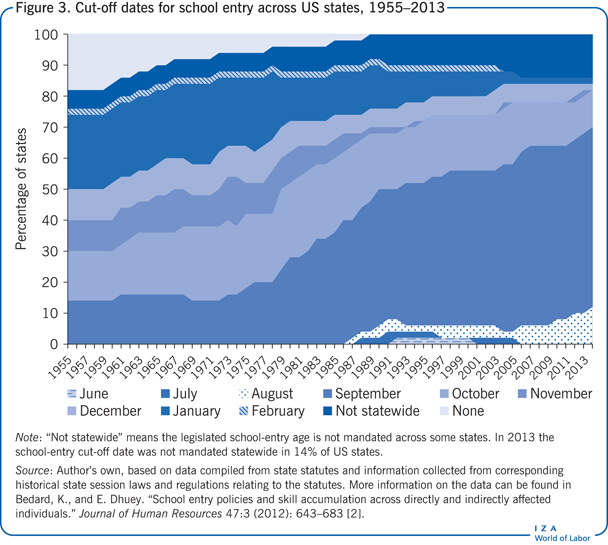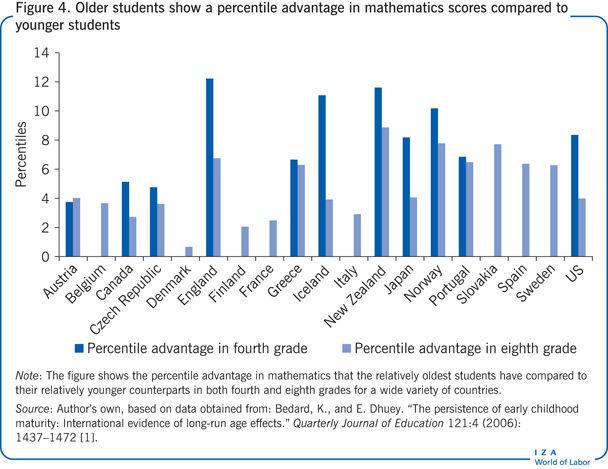Elevator pitch
Laws on age at school entry affect student achievement and often change for a number of reasons. Older students are more mature and ready to learn. This can have positive impacts on academic, employment, and earnings outcomes. The costs of holding children back include another year of childcare expenses or income forgone by the caregiver parent. Entering the workforce one year later also has implications for lifetime earnings and remittances to governments. School-entry policies could be a useful tool in increasing student achievement, but the short- and long-term impacts need to be better understood.
Key findings
Pros
The school-entry age has been decreasing around the world; however, in the US, the opposite has been occurring.
The trend in the US is partly due to changes in school-entry cut-off dates, but more parents—often of higher incomes—are also delaying their children’s school entry.
Increasing the school-entry age by changing the cut-off date can lead to increased future wages.
Being the oldest student within a group has strong short-term effects on outcomes, such as test scores, special-needs diagnosis, and leadership.
Cons
The optimal school-entry age is unknown and likely to depend on external factors, such as access to early childhood education.
More parents in the US are delaying their children’s school entry, despite mixed evidence of its benefits.
Findings on the effects of being older within a student group are inconclusive with respect to long-term outcomes, such as educational attainment, employment, and earnings.
It is uncertain whether the positive effects of being older within a group are due to the student’s age relative to their peers or the student’s absolute older (calendar) age.
Author's main message
The school-entry age has been decreasing globally, but the opposite is occurring in the US. School-entry cut-off dates continue to change; parents are also holding their children back to increase their learning readiness. There are advantages in being older at school entry, but younger students also benefit from having older students in the same class. However, the optimal school-entry age is still unknown and likely depends on jurisdictional factors such as access to early childhood education. As changes in school-entry age affect student achievement, policymakers need to decide what the optimal age is and the best way to implement it.
Motivation
Discussions on school-entry age center on two important questions. What is the optimal age for children to begin school? And, given a particular jurisdiction’s mandated school-entry age, at what age should an individual child begin school? The first is a policy question that is relevant for a society; the second question is relevant to a particular family.
Governments often mandate the school-entry age. However, many jurisdictions offer some latitude to a particular child, regardless of the legislated age. In some countries, such as the US, it is becoming conventional wisdom that to succeed in school, children need to be older when they start. So, if a child happens to be born in a month that would have them younger when entering school, their parents will often hold them back another year. Also, each year before the start of school, the popular media publish articles on the question of whether children should be held back a year longer. As more parents are waiting an extra year to enroll their children in primary education, the question of whether a late start is indeed a smarter start becomes increasingly important. In addition, more jurisdictions are moving their school-entry age cut-off dates. In some, children are older when they begin school; in others, they are starting at younger ages. All of this leads to the same question: Does the school-entry age matter? And if so, how much?
Discussion of pros and cons
School starting ages vary across countries
The legislated school-entry cut-off date indicates the date by which children need to be a certain age before they begin primary school. Across the world, countries start their children at different ages (Figure 1). In some countries, children begin at age five; in others, they begin at age seven. Most countries start their children at age six.
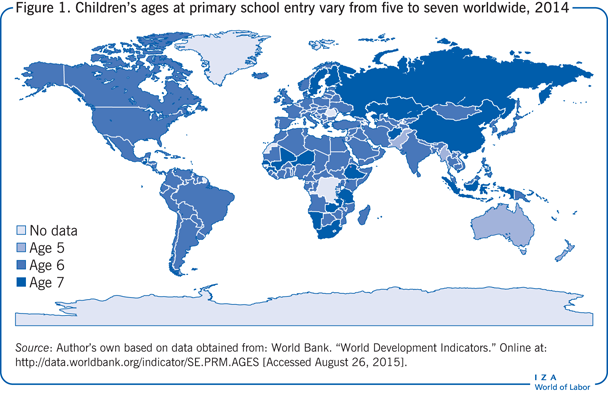
During the last 50 years, school-entry ages have been decreasing across the world (Figure 2). A clear pattern emerges over the period 1970 through 2014: While a small, stable share of countries has been consistently starting their children at age five, most countries have been moving their school-entry age from age seven to six, particularly since the mid-1990s.
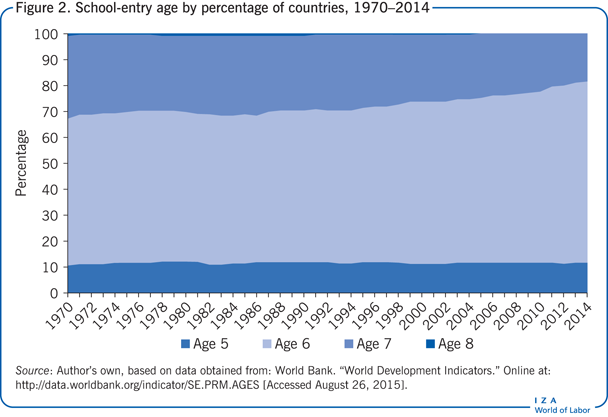
Interestingly, the opposite trend has been occurring in the US (Figure 3). Here, over the period 1955 through 2013, states have been moving their cut-off dates from later to earlier in the school year; from January toward September [2]. Whereas, previously, children who would be turning six in January could begin school in September at age five, this policy change meant that they now had to be turning six closer to the first day of school. A January 1 cut-off implies a school-entry-age range of 56 to 67 months (4.7 to 5.6 years of age), while a September 1 cut-off implies an entry-age range of 60 to 71 months (5.0 to 5.9 years of age), the latter cut-off ensuring that children are older when they begin school [2].
The overall trend toward children being older at school entry, as observed in the US, has been referred to as the “greying of kindergarten” [2] and is supported by school-enrolment data. Accordingly, 96% of six-year-olds were enrolled in first grade or above in the fall of 1968, while in 2005 this proportion had dropped to 84%. At the same time, the school-attendance rate remained steady, but now kindergarten classes consisted of a substantial share of six-year-olds who would otherwise be entering first grade. Overall, 25% of the change was due to adjustments in the school-entry cut-off dates (as shown in Figure 3) and 75% was due to parents delaying their children’s entry into school [3].
The benefits of starting school later
Policymakers and parents hold their children back in an effort to improve their learning outcomes. In the US school-entry-age cut-off dates have been changing for three reasons. First, when policymakers opt for an earlier cut-off date, this ensures the student group entering primary school is older, on average, than they otherwise would have been, which may improve their school readiness [2]. Second, and perhaps most important to policymakers, backing up the cut-off date means the students in this group are older when taking national and international assessments, which may improve their relative test-score rankings. Finally, backing up the cut-off date generates a temporary reduction in group size, which can result in temporary savings for governments [2].
The greying of kindergarten may not be a bad thing. In fact, using birth cohorts in the US from the 1960s and 1970s, it was estimated that backing up the school-entry cut-off date had positive long-term effects. In particular, it was found that changing the cut-off by one month (i.e. from January 1 to December 1) increased male hourly earnings, on average, by approximately 0.6% [3]; however, there was little impact on average female hourly earnings. As this changes the average school-entry age by about three months, it implies an increase in the average hourly earnings of males by 1.8%. This impact is sizable and points to a substantial return to an increased average age at school entry for males when moving the school-entry-age cut-off range from September 1 through January 1. These estimates should be interpreted as the average effect of the policy shift across all children [2].
Parents are increasingly “redshirting” their children
When parents hold their children back from school, in an effort to improve their learning outcomes, this is called “redshirting.” The term was coined in sports in reference to the red jerseys athletes wore in their first year of university athletics to indicate that they were delaying their participation in a particular sport to lengthen their period of eligibility. Redshirting is used in an academic sense when parents decide to delay enrolling their child in school despite the child being eligible to attend.
Approximately 4−6% of children in the US are redshirted. These children tend to be more likely male, white, and from families of high socio-economic status [4]. Parents redshirt their children for a variety of reasons, including believing that they are not developmentally ready for school or to give them a strategic advantage by allowing them to become older, bigger, taller, or to possess more social and cognitive skills than their younger classmates. However, despite the perceived advantages, there is little evidence of the benefits of redshirting. It is difficult to estimate its effects because it is not possible to know how well a child would have done if he or she had not been redshirted. A researcher cannot simply compare a child who is redshirted to a child who is not, as other factors may bias the results.
Recently, some researchers tried to overcome this problem by using an experiment that randomly moved children of the same age to different kindergarten classrooms [5]. Although the absolute age was the same, the children’s ages changed relative to those of their classmates. This scenario would be similar to one wherein the average age of the student group changed because more parents decided to redshirt their children or a policy change moved the school-entry cut-off date. This research found that, on average, having older classmates improved educational outcomes, including tests scores, for up to eight years after kindergarten and increased the probability of students taking a college entrance exam. This implies that having redshirted children in a class may benefit all students and not only those who are held back. However, it is also important to realize that a high rate of redshirting, which will influence a class’s age composition, may alter the curriculum and instruction to the student group, which has impacts not measured in this particular set up [5].
Redshirting has potential economic effects on the family and on society. It can cost a family an additional year of childcare or a year of income forgone for a caregiver parent. For some children, entering school later is associated with increased rates of dropping out in jurisdictions where compulsory schooling laws are based on age. For instance, compulsory school completion laws in the US are age-based, instead of grade-based, meaning a child needs to stay in school until they are a certain age regardless of the grade level attained. This differs from many jurisdictions in the world in which a child needs to stay in school until they finish a particular grade. Additionally, a child who is redshirted will delay entering the workforce by a year, which might have consequences on lifetime earnings. Finally, a student’s late entry into the workforce could have societal costs as they may pay one year less into pension plans, such as Social Security in the US [3].
Relative age
Unlike redshirting, a great deal is known about relative-age effects. Relative age often describes the combined effect of the child’s age when they start school, the age of the child at testing (or outcomes measuring), and the age of the child relative to their peers. The usual approach is to use the variation in birth date relative to the school-entry age of a given jurisdiction to estimate the benefit of being relatively older within a student group [2]. This technique estimates the combined effect of both the relative and absolute age.
Overall, the literature finds that children who are relatively older than their classmates at the beginning of primary school have a number of short-term advantages, such as scoring higher on standardized exams through primary and secondary school (Figure 4) [1]. These children are more likely to have high-school leadership experience [6], are more likely to be enrolled in pre-academic university-track programs and high-end universities [1], and are less likely to be identified as disabled and receiving special education services [7], among other outcomes.
Figure 4 provides evidence of the advantage of older students compared to younger students in mathematics. Scores of grade four and grade eight students are compared across OECD countries. The figure shows that older students have a distinct advantage compared to younger students at both grade levels, but this advantage is somewhat smaller in grade eight, except in Austria. For example, in Japan, older students in grade four have an advantage of almost 12 percentiles, whereas in grade eight the advantage is only about eight percentiles.
Early differences in maturity at school entry can enhance a student’s knowledge and skills development throughout childhood, adolescence, and adulthood, and may have important long-term implications for productivity, employment, and earnings. Attempts to estimate the impact of age at school entry on a number of adult outcomes have led to mixed and sometimes inconclusive results. For instance, being young at school entry increases the probability of teenage pregnancy, but the long-term wage effects of being young at school entry are still unknown [8], [9]. On the contrary, entering school at a younger age can result in higher wages and increased educational attainment [10]. The contrasting results may be partially due to the interaction between starting school later and dropping out of school earlier in countries where compulsory school-attendance laws are based on age instead of grade level. That is, a proportion of students who entered school late may drop out of secondary school in an earlier grade because they had already reached the end of their compulsory schooling. However, for some of the relatively younger students, it is clear that there may be significant benefits to completing school and entering the workforce one year earlier. Overall, it is difficult to separate these effects on the long-term outcomes of students in these groups.
Recent literature has tried to separate the combined relative-age effect into its separate effects: age at school entry, age at the time of testing or outcomes measuring, and age relative to peers. In devising educational policies and practices that are based on student age it is important to distinguish between the effects of absolute and relative age. In particular, it is useful to distinguish between the effect of age at school entry and the effect of age at testing or outcomes measuring because it could be that children who start school at an older age do better simply because they are being assessed when they are older, or it could be that starting school at an older age, in itself, is advantageous [8]. A number of researchers have tried to separately estimate the components of the relative-age effect. Some have separately estimated absolute age (school-entry age or age at testing) from age relative to classmates. Findings show that the absolute age of a child has a larger influence than the child’s age relative to their classmates on outcomes [5], [11]. Researchers disagree on whether these effects dissipate over time. Some find that they do [11], while others find they do not [5].
Other studies have attempted to separate the effects of school-entry age from age at the time of testing, finding small positive effects of starting school at a younger age. However, these effects are dwarfed by the larger positive effects of being older during testing [8].
Overall, being older than one’s classmates in an absolute sense has large positive impacts and being relatively older has negative effects. However, when a child is redshirted, the large absolute positive effects dwarf the smaller negative relative effects. In addition, it seems that other classmates benefit from redshirting, simply by being in the same class with older students. However, this only holds for current levels of redshirting and it is not possible to predict what would occur if a higher percentage of parents were to hold their children back [5].
What is the optimal age for school entry?
Despite all the evidence regarding age at school entry, the optimal school-entry age is still unknown. In the US there are gains associated with backing up the school-entry cut-off date from January to September, but it is uncertain as to whether there would be gains or losses associated with further backing it up [2]. There are gains from children being redshirted, but it is not possible to determine what the gains would be if a higher percentage of parents were to hold their children back.
The optimal age for school entry may also depend on factors that are jurisdiction specific, such as access to early childhood education programs, maternal labor supply rates, or childcare prices, quality, and availability.
Limitations and gaps
Many questions regarding the optimal age of school entry remain unanswered. For example, the influence of the culture or the curriculum of different jurisdictions on students’ learning outcomes is unknown. Access to preschool programs might also be a factor. In the US, five might be the optimal age to start school; however, in a country with a more comprehensive universal childcare system, such as Norway, children could possibly begin school later because they are already receiving some early childhood education.
Other questions on the school-entry-age effects center on the effect of age on students’ long-term outcomes. Here, it is difficult to separate the impact of students being older in an absolute (calendar age) sense from the impact of being relatively older than the other students in a class. This is a difficult topic to address as it generally requires large data sets that contain sensitive information such as birth dates, and these are not easy to obtain.
Understanding the mechanisms of the relative-age effects on students’ educational outcomes and how they propagate themselves across time, and over a variety of factors, would be helpful in forming sound educational policy.
Summary and policy advice
The age at which a child enters primary school may have consequences on their later academic, employment, and earnings outcomes. A child who starts school at an older age has advantages in primary education, which can continue into adulthood. Nevertheless, there are also drawbacks that range from a higher probability of dropping out before high-school completion (depending on the jurisdiction), to entering employment a year later. Families also incur costs from a child’s late start in childcare costs or income forgone while taking care of the child at home.
The question of whether students benefit from being older relative to the other students in a class or whether it is better to be older in an absolute sense is difficult to address, and results from empirical studies are mixed, at best. Nevertheless, governments continue to change laws on age at school entry in efforts to improve student outcomes.
Many of the current changes to school-entry policies are related to temporarily increasing standardized test scores or saving money from holding a student group back for a year. However, it is crucial to understand how policies—such as school-entry cut-off dates, how to address “redshirting,” the role of retention, ability grouping, special education, and compulsory school-attendance laws—interact with a child’s age. Understanding this intersection is crucial for sound and successful education policy formation.
Acknowledgments
The author thanks an anonymous referee and the IZA World of Labor editors for many helpful suggestions on earlier drafts. Previous work of the author together with Kelly Bedard and Stephen Lipscomb contains a larger number of background references for the material presented here and has been used intensively in all major parts of this article [1], [2], [6], [7].
Competing interests
The IZA World of Labor project is committed to the IZA Guiding Principles of Research Integrity. The author declares to have observed these principles.
© Elizabeth Dhuey
